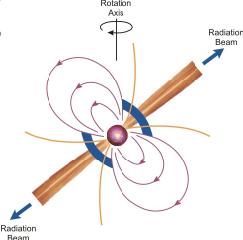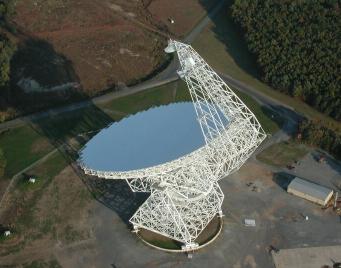Youngest Radio Pulsar Revealed with the Green Bank Telescope
23rd May 2002
University of Manchester astronomers, as part of a world-wide collaboration, have discovered the youngest known radio-emitting pulsar. They used the world's largest fully steerable radio telescope to detect remarkably faint radio signals from an 820 year-old pulsar associated with a supernova remnant located 10,000 light years away in the constellation Cassiopeia. This is one of the first key discoveries made by the newly commissioned, 105-m diameter, Robert C. Byrd, Green Bank Telescope located in West Virginia, USA. This discovery, the result of the most sensitive radio observations ever made in the search for pulsars, will enable scientists to conduct further observations that could lead to a better understanding of how these stellar remnants evolve.
"Important questions about pulsars may be answered by long-term monitoring of objects such as the one we have just detected," said the group leader Fernando Camilo of Columbia University in New York City. "Young pulsars are particularly rare, and being able to study such a young one at radio wavelengths provides an outstanding opportunity to learn critical facts about their evolution and workings."
Scientists have long suspected that a pulsar - a rapidly spinning, superdense neutron star - was born when a giant star ended its life in a cataclysmic supernova explosion observed in late summer of 1181, as suggested by Japanese and Chinese historical records. For the past 20 years, astronomers have searched this supernova remnant (3C58) for the telltale pulsations of the pulsar. Late in 2001, data from NASA's Chandra X-ray satellite confirmed its existence, but it remained an elusive quarry for radio telescopes.
"We believed from historical records and certainly knew from recent X-ray observations that this star was there," Camilo remarked, "but despite many attempts, no one had been able to find any radio pulsations from it because the signals are, it turns out, incredibly weak." For comparison, this pulsar's radio emission is some 250 times weaker than that from the famous pulsar in the Crab Nebula (the remnant of an explosion in the year 1054 recorded by Chinese astronomers).
"Although we knew what we were searching for," said Ingrid Stairs, team member from NRAO Green Bank, "it took the new Green Bank Telescope with its unmatched sensitivity -- and, importantly, location in a National Radio Quiet Zone -- to make this remarkable detection." The newly detected pulsar, known as PSR J0205+6449, is currently rotating 15 times every second.
By detecting this pulsar in the radio part of the spectrum, astronomers may now follow its evolution with greater ease and flexibility than with X-ray telescopes on satellites, study the pulsar emission mechanisms, and also characterize the dynamic interstellar medium between the Earth and the pulsar.
"Continued observations of such a young radio pulsar will provide a mine of information for years to come," noted Duncan Lorimer of the University of Manchester. "We will be able to precisely track how its rate of rotation changes over time, potentially inferring fundamental clues about what causes a magnetized neutron star to spin down. We also be able to make valuable comparisons to the X-ray data, which may help us determine exactly how and where these stars generate and emit radiation."
The researchers also point to the fact that this discovery bodes well for the Green Bank Telescope being able to study additional young pulsars that have previously escaped detection. "By using this magnificent new telescope, we should be able to discover other very young pulsars that we surmise are there, but are simply too weak to detect by any other means," said Camilo. "Measuring the luminosity and spectrum of a large sample of these stars will be crucial for making an accurate census of pulsars in our Galaxy."
The researchers used the new Berkeley-Caltech Pulsar Machine designed by Donald C. Backer at UC Berkeley to process the signals from the GBT and record them for later analysis using software written primarily by the research team members at the University of Manchester.
The group led by Camilo in this investigation consists also of: Ingrid H. Stairs (NRAO Green Bank, West Virginia); Duncan R. Lorimer, Michael Kramer, Maura A. McLaughlin (University of Manchester, Jodrell Bank Observatory, Cheshire, U.K.); Donald C. Backer (University of California, Berkeley); Scott M. Ransom (McGill University, Montreal, Canada); Bernd Klein, Richard Wielebinski, Peter Muller (Max-Planck-Institut fur Radioastronomie, Bonn, Germany); and Zaven Arzoumanian (Universities Space Research Association/NASA-Goddard Space Flight Center, Greenbelt, Maryland).
Further information:
A pulsar is formed when a massive star runs out of nuclear fuel and dies in a cataclysmic explosion called a supernova. The outer layers of the star are blown off into space, and are often seen as an expanding remnant shell of hot gas. The core of the star, with 40 percent more mass than our Sun, collapses under its own gravity to a sphere only about 10 miles in diameter, composed mostly of neutrons. These, the densest objects known in the Universe, are typically born spinning very rapidly. They have very powerful magnetic and electric fields that accelerate electrons and other subatomic particles, causing them to emit beams of radio waves, X-rays, and other forms of radiation. If these beams intersect the Earth as the star rotates, we can then detect the pulsar, as it appears to flash on-and-off, much like a lighthouse. As the pulsar ages, it gradually slows down and loses its rotational energy. After a few million years it is no longer powerful enough to generate radio emission and "turns-off."
The Green Bank Telescope is the world's largest fully steerable radio telescope. It was dedicated on August 25, 2000. It is a major instrument of the National Radio Astronomy Observatory, a facility of the National Science Foundation, operated under cooperative agreement by Associated Universities, Inc.
CONTACTS:
Dr. Duncan Lorimer, University of
Manchester, Jodrell Bank Observatory, Cheshire, UK
+44-1477-572-675 drl@jb.man.ac.uk
Dr. Fernando Camilo, Columbia University,
USA
+1-212-854-2540 fernando@astro.columbia.edu
Dr. Ingrid Stairs, NRAO Green Bank, West Virginia, USA
+1-304-456-2213 istairs@nrao.edu




